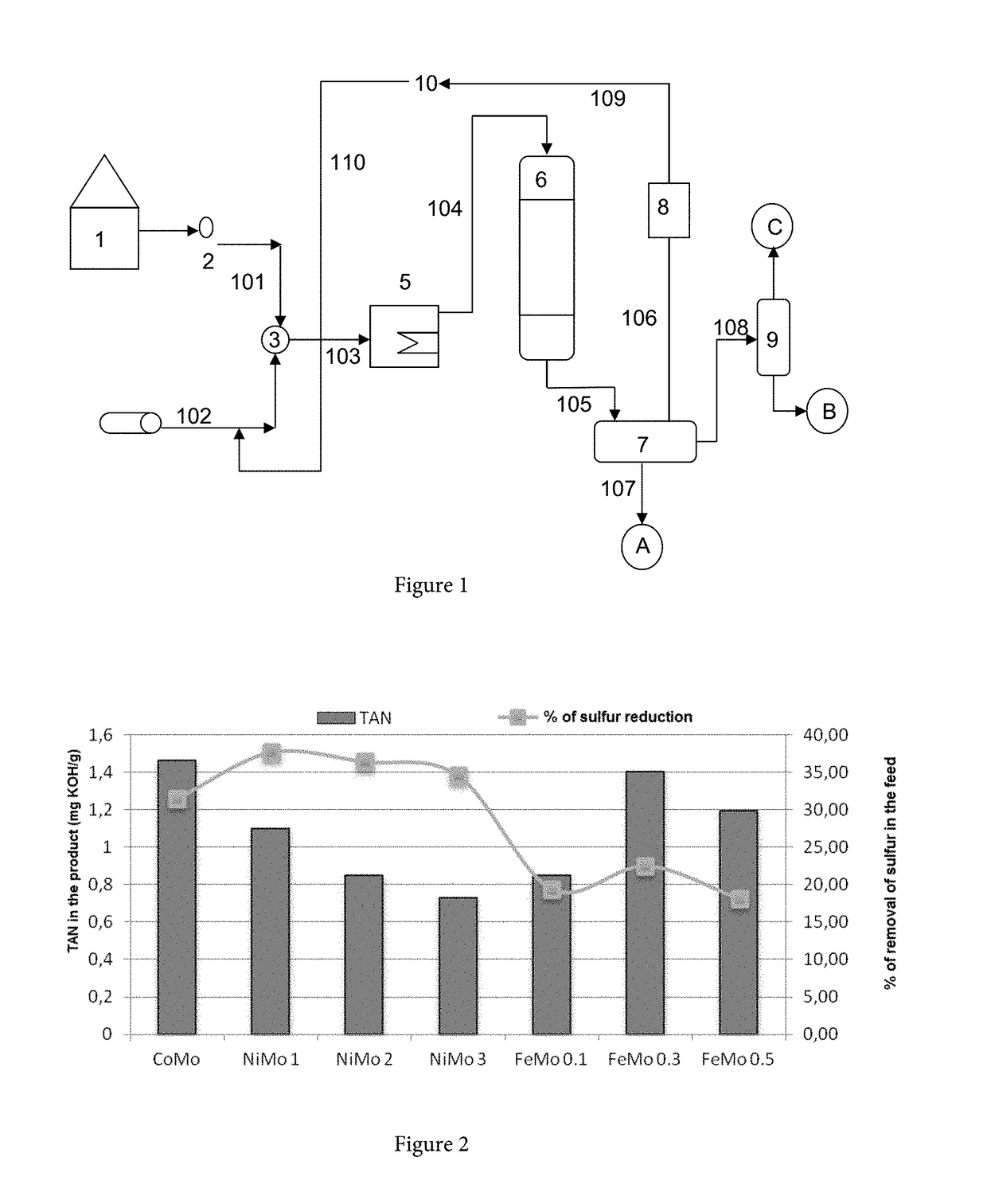Improved method for the reduction in acidity in crude oils with a high naphthenic acid content by means of catalytic hydrogenation
a technology of crude oil and acidity reduction, which is applied in the direction of catalyst activation/preparation, metal/metal-oxide/metal-hydroxide catalyst, physical/chemical process catalyst, etc., can solve the problems of preventing the processing of these types of crude oil at refineries, and producing atypical corrosion phenomena of naphthenic acids
- Summary
- Abstract
- Description
- Claims
- Application Information
AI Technical Summary
Benefits of technology
Problems solved by technology
Method used
Image
Examples
example 1
[0020]Results obtained through tests conducted with hydro treatment commercial catalysts such as CoMo, NiMo1, NiMo2, NiMo3 and Fe—Mo catalyst supported on alumina with a molybdenum concentration of 10% and a variation of the atomic ratio of Fe with respect to Mo between 0.1 and 0.5 are shown below. The Fe—Mo catalyst has a total area of 256 m2 / g, pore volume of 0.63 cm3 / g and pore diameter of 97.84 Å.
[0021]All of the catalysts were evaluated with heavy crude (Table 1) in a shaker tank reactor in presence of hydrogen and catalyst feed of 90 cm3; operating conditions for the hydro treatment were 573.15 K and 623.15 K at pressure of 4.13 MPa psi and LHSV of 1.1 h−1.
TABLE 1Feed characteristics: heavy crudePropertyMethodUnitMeasureSulphurASTM D4294% Weight1.6DensityASTM D 5002Kg / m3989.2API gravityASTM D 5002°API11.4Acid numberASTM D 664mg KOH / g7.113Kinematic viscosity 80° c.ASTM D 445mm2 / s251.5Water contentASTM D 4377% peso1.62
[0022]FIG. 2 and FIG. 3 show the comparison of the characteri...
example 2
[0028]FeMo and Mo catalysts supported in alumina and Mg-aluminum spinel were evaluated at pilot scale, aimed at analyzing the contribution of the Fe and that of the support in the hydro deoxygenation process. A CSTR reactor with a 90 cm3 loading catalyst was used for such tests, which was previously activated with dimethyl disulfide at 2% (v / v) under 593 K, LHSV: 1.1 h−1 conditions and a hydrogen / dimethyl disulfide relation of 120 Nm3 / m3.
[0029]Subsequently, each catalyst was fed with 7 mg KOH / g acidity crude, at two different temperature conditions: 573 K and 623 K at a pressure of 4.13 MPa, LHSV: 1.1 h−1 and at a volume flow of hydrogen of 0.014 Nm3 / h. At the same time the stability of each catalyst was evaluated returning to the initial temperature condition of 573 K.
[0030]The textural characterization reported in Table 2 showed that the pore diameter varies from 90 Å to 115 Å, total area between 180 and 280 m2 / g and the pore volume goes from 0.4 to 0.7 cm3 / g. Based on gases adsor...
example 3
[0040]One of the most attractive methods to perform the removal of acidity is the decarboxylation of the naphthenic acids on basic catalysts. The adequate catalytic materials to carry out the reaction are composed by inorganic metals, specifically carbonates, basic carbonates and oxide of alkaline-earth metals (Be, Mg, Ca, Sr and Ba). Under such conditions, a set of experiments that included the comparison of the commercial MgO / γ-alumina and the CaO catalysts (supported in γ-alumina and bohemite) were conducted using different percentages of Ca to verify the selectivity in the process of removal of naphthenic acids.
[0041]All the catalysts were evaluated with heavy crude according to the characterization reported in Table 4, in a reactor of a shaken tank in presence of hydrogen with a 9 e-5 m3 of catalyst load. The operation conditions of hydro treatment were of 573 K and 623 K at a pressure of 4.13 MPa and LHSV of 1.1 h−1.
[0042]FIG. 8 shows that the percentage of acidity removal in ...
PUM
| Property | Measurement | Unit |
|---|---|---|
| Temperature | aaaaa | aaaaa |
| Temperature | aaaaa | aaaaa |
| Temperature | aaaaa | aaaaa |
Abstract
Description
Claims
Application Information
 Login to View More
Login to View More - Generate Ideas
- Intellectual Property
- Life Sciences
- Materials
- Tech Scout
- Unparalleled Data Quality
- Higher Quality Content
- 60% Fewer Hallucinations
Browse by: Latest US Patents, China's latest patents, Technical Efficacy Thesaurus, Application Domain, Technology Topic, Popular Technical Reports.
© 2025 PatSnap. All rights reserved.Legal|Privacy policy|Modern Slavery Act Transparency Statement|Sitemap|About US| Contact US: help@patsnap.com



